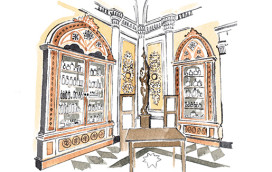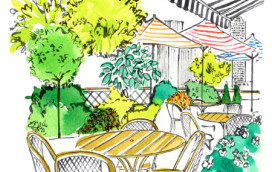
A linen shop in Mumbai
by David Linley
Khadi Stores, 145 Prathana Samaj, Ram Mohan Road, Mumbai
I went to this shop primarily because Amin Jaffer, international director of Asian art at Christie’s in India, took me there – so it’s really his Little Place I Know, which I’ve learned to love too. Like all the best places, it’s in a nondescript alley, in a nondescript building. But once you’ve gone up the stairs, you find yourself in an Aladdin’s cave of linens; it’s a purveyor of the finest khadi (or hand-woven) cloth in India. What’s interesting about khadi is that it’s not just cloth. In 1918, Mahatma Gandhi encouraged everyone in India to spin and weave, as a way of reducing dependency on Britain. So the cloth also has political resonance (hence Khadi Stores’ motto: “The Original Freedom Wear Since 1937”). The Maheshwari family has had Khadi Stores for four generations, and the father and son who run it are always dressed beautifully with their crisp white shirts, waistcoats and Nehru jackets. All their cotton is exquisite, from dhoties and kurtas to tablecloths and bedspreads, and all neatly stocked in one big room. Should you want to see something, it’s extracted and shaken out: a very good sales trick, because you then feel obliged to take it. Most things are hard to resist, anyway. Amin Jaffer always ends up buying all sorts, and I keep thinking about a beautiful throw. I haven’t given in... yet.
David Linley, a nephew of the Queen, is an English furniture-maker and honorary UK chairman of the auction house Christie’s
Your address: The St. Regis Mumbai
A trattoria in Rome
by Anna Fendi
Trattoria Al Moro, Vicolo delle Bollette 13, Rome
This will always be my favorite place to eat in Rome; it’s where my husband took me on our first date, and we discovered we had the same favorite dish. It’s like stepping inside a time capsule, with the walls of its three smallish dining rooms covered in newspaper clippings and photographs. It’s full of history: Mario Romagnoli (whose nickname was Il Moro) started it in 1929, and it’s now run by the third generation of Romagnolis, who have served every artist, performer and filmmaker who has come to Rome. The staff are also part of the restaurant’s appeal: older Italian men, who are kind and attentive, especially with difficult customers like me. Although they’re well known for their spaghetti al Moro (a piccante reinterpretation of carbonara), my favorite is zuppa di arzilla, a humble Roman soup with fresh vegetables and stingray, which is incredibly delicate and delicious. They also have an extensive wine list, handwritten in a giant book. Everything about it is special, which is why it’s full of Romans.
Anna Fendi is head of development for her family’s fashion brand.
In 2016 she launched her own tableware and wine company
Your address: The St. Regis Rome


A Scandinavian
gallery in New York
by Eva-Lotta Sjöstedt
Scandinavia House, 58 Park Avenue, New York
The American-Scandinavian Foundation, established in 1911, opened the Scandinavia House at the start of the millennium as a showplace for Scandinavian culture and life. Today it has several exhibitions a year, ranging from photography and painting to fashion and literature. From outside, it’s quite modern-looking: a discreet entrance, near the best shops in and around Madison Avenue, framed by flags from Denmark, Sweden, Norway and Finland. Inside, you see extraordinary things that you’d never see elsewhere; a few years ago, for example, there was a beautiful exhibition of paintings from the Danish Golden Age from the private collection of John L. Loeb Jr., the former US ambassador to Denmark. The center puts on exhibitions that explore nature and sustainability, concerts, panel discussions and film screenings that focus on Nordic life. It’s very special to me; not only is it a place to keep in touch with my Nordic heritage, it’s also a Scandinavian sanctuary in the middle of the hustle and bustle of New York.
Eva-Lotta Sjöstedt is CEO of the Danish design brand Georg Jensen
Your address: The St. Regis New York
A Tibetan café in Lhasa
by Jean-Michel Gathy
Mayke Ame, Barkhor Street, Lhasa
In Tibet, everything people do has a religious and spiritual value. The most important temple in Lhasa is the Jokhang, which is surrounded by sub-temples, and a long path, about a kilometer long, which goes around the edge of the complex. Tibetan pilgrims walk around it, clockwise, praying and turning prayer wheels as they go, and perhaps stopping off for some refreshment afterwards. Of many restaurants near the temple, I particularly like a very Tibetan one that is always full of local people. It’s two levels high: on ground level is the owner’s house, and about 12ft above that, a mezzanine restaurant. Its architectural language is simple, unadorned – it’s merely a place to stop and eat after you’ve finished your prayers. Unlike the temples below, which are incredibly peaceful, up there it’s chaotic: packed with tables and Tibetans in religious dress. There’s a real spirit about it, a real soul. You could stay there three hours just watching people come and go, and walking around below, doing their prayers in an uninterrupted line. You don’t go for the comfort, or the food. They eat yak, which they cook in yak butter, so it’s incredibly fatty and rich, with a local big fat potato from the Himalayas, and beans with a tomato sauce. I try not to eat – you wouldn’t unless you were incredibly hungry; I usually have tea. The people serving are all lovely Tibetans: high-cheekboned, black-haired, smiling people with reddish skin. It’s a bit like going to Café de Flore in Paris; you don’t go for the food, you go for the street life.
Jean-Michel Gathy is a leading hotel designer
Your address: The St. Regis Lhasa



